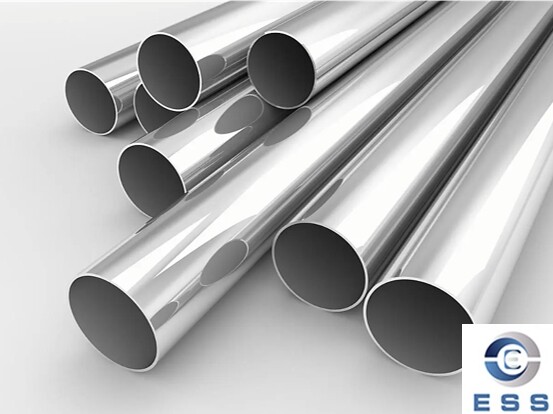
Stainless steel has good comprehensive
performance and good appearance surface characteristics, and is widely used in
all walks of life. Similarly, stainless
steel pipes are no exception. Stainless steel pipes are a type of steel
with a hollow cross-section, generally divided into seamless
steel pipe and welded
steel pipe. There are also certain differences in their processing methods
and performance, as follows:
Differences in manufacturing process
Stainless steel seamless pipes use round
tube billets as raw materials for perforation, and are made through cold
rolling, cold drawing or hot extrusion production processes. There are no
welding points on the pipes; welded pipes are made of steel plates or steel
strips after being curled and formed by the unit and the mold, and the inner
wall of the pipe generally has a weld.
Differences in the appearance of steel
pipes
Stainless steel seamless pipes have low
steel pipe precision, uneven wall thickness, low brightness of the inner and
outer surfaces of the pipe, high sizing cost, and pitting and black spots on
the inner and outer surfaces that are difficult to remove. Therefore, the walls
of seamless pipes usually produced are thicker.
The tolerance of the wall thickness of the
welded pipe is very small, and the wall thickness of the entire circumference
is very uniform; the steel pipe has high precision, the inner and outer
surfaces of the pipe are bright, and can be arbitrarily sized; it can be made
into thin-walled pipes.
Differences in performance and price
Stainless steel seamless pipes are usually
superior to welded pipes in terms of corrosion resistance, pressure bearing and
high temperature resistance. It can withstand higher pressures and
temperatures, and is very suitable for fluid transportation applications that
require high strength and high temperature resistance. Due to the improvement
of production processes, the mechanical properties and mechanical properties of
welded pipes are gradually approaching those of seamless pipes, but the price
is usually more economical and suitable for low pressure or applications that
do not require extremely high strength.
Features of stainless steel seamless
pipes
1. Advantages
High strength: Seamless steel pipes have
superior performance under high pressure and high temperature, and are suitable
for harsh industrial environments.
Forming diversity: It can be made into a
variety of cross-section forms to flexibly respond to the needs of different
use conditions.
Improved mechanical properties: After cold
rolling or hot rolling, the grain of the seamless steel pipe is refined, the
mechanical properties are significantly improved, and it has better wear
resistance and corrosion resistance.
2. Disadvantages
Uneven wall thickness: Uneven wall
thickness of steel pipes is common during cold rolling, and some pipes may have
residual stress and surface defects as they cool.
Poor surface finish: There may be traces on
the inner surface of the steel pipe, which are not easy to remove, affecting
the appearance and fluidity of the fluid in the pipe.
Features of stainless steel welded steel
pipes
1. Advantages
Uniform wall thickness: The wall thickness
of welded steel pipes is relatively uniform, which can maintain high production
accuracy and is suitable for large-scale industrial applications.
Low residual stress: After bright annealing
treatment, the residual stress of welded steel pipes is effectively eliminated,
and the stability of the pipe is relatively high.
Lower production cost: Compared with
seamless steel pipes, the production process of welded steel pipes is simpler,
the price is more economical, and it is suitable for mass production.
2. Disadvantages
The existence of weld seams: There are weld
seams inside the welded steel pipe. Although it has been treated at high
temperature, the weld seams may still affect the strength of the pipe,
especially under high pressure.
Weak pressure resistance: Compared with
seamless steel pipes, welded steel pipes have poor corrosion resistance and
pressure bearing performance, and cannot meet the needs of some harsh
environments.
Based on the features and differences
between stainless steel seamless pipes and welded pipes, reasonable selection
should be made when applying to achieve economic, beautiful and reliable
effects:
1. When making decorative pipes, product
pipes, and prop pipes, good surface effects are generally required, and
stainless steel welded pipes are usually selected.
2. For generally low-pressure fluid
transportation, such as transportation of water, oil, gas, air, and
low-pressure systems such as heating hot water or steam, stainless steel welded
pipes are usually selected.
3. For pipelines used to transport fluids
in industrial engineering and large equipment, as well as pipelines for
transporting fluids that require high temperature, high pressure, and high
strength on boilers in power plants and nuclear power plants, stainless steel
seamless pipes should be selected.
4. Stainless steel welded pipes are
generally used for liquid transportation below 0.8MPa, and seamless pipes can
be used to withstand liquid transportation above 0.8MPa. If the pressure
requirement is not high, it will be more economical to use welded pipes.













 Eastern Steel Manufacturing Co.,Ltd not only improve product production and sales services, but also provide additional value-added services. As long as you need, we can complete your specific needs together.
Eastern Steel Manufacturing Co.,Ltd not only improve product production and sales services, but also provide additional value-added services. As long as you need, we can complete your specific needs together.










